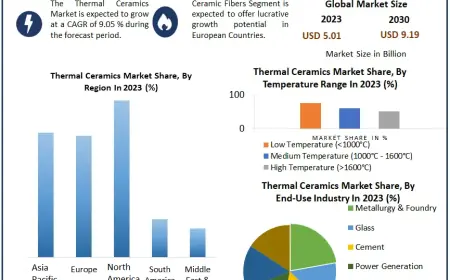Boost Sales & Delight Customers: How the CRM Market Drives Success
The global customer relationship management market is expected to experience robust growth at a healthy compound annual growth rate (CAGR) from 2022 to 2028.

Infinium Global Research recently published a report on the customer relationship management market, offering detailed analysis of global and regional segments and sub-segments. The study examines how drivers, restraints, and macroeconomic indicators impact both short-term and long-term trends in the global and regional customer relationship management markets. The report comprehensively presents trends, forecasts, and monetary values for the global customer relationship management market. According to the findings, the market is expected to experience robust growth at a healthy compound annual growth rate (CAGR) from 2022 to 2028.
Market Dynamics:
1. Technological Advancements: Continuous advancements in AI, automation, and analytics within CRM software are enhancing its capabilities to deliver personalized customer experiences and operational efficiencies.
2. Business Transformation: CRM is pivotal in transforming business operations by centralizing customer data, facilitating targeted marketing campaigns, and improving sales processes.
3. Demand for Customer Insights: Businesses increasingly rely on CRM to gain actionable insights into customer behavior, preferences, and trends, thereby enabling proactive decision-making and personalized customer interactions.
4. COVID-19 Acceleration: The COVID-19 pandemic has accelerated digital transformation initiatives, prompting organizations to adopt CRM solutions for remote customer engagement and service continuity.
5. Challenges and Solutions: Challenges such as data security concerns, integration complexities, and user adoption barriers are being addressed through innovations in cloud computing, cybersecurity measures, and user-friendly interfaces.
Regional Analysis:
North America:
- North America leads the global CRM market due to a robust ecosystem of CRM vendors, high adoption rates across industries including technology, finance, and retail, and early adoption of advanced CRM technologies.
- The region serves as an innovation hub for CRM solutions, driven by investments in R&D and a mature IT infrastructure supporting cloud-based deployments.
Europe:
- Europe exhibits strong CRM adoption across diverse verticals such as automotive, healthcare, and telecommunications, driven by stringent data protection regulations and a focus on enhancing customer relationships.
Asia-Pacific:
- The Asia-Pacific region is experiencing rapid CRM market growth fueled by increasing digitalization, expanding e-commerce landscapes, and a burgeoning SME sector adopting CRM to enhance customer engagement and operational efficiency.
Latin America and Middle East/Africa:
- These regions are witnessing increasing CRM adoption driven by economic diversification, digital transformation initiatives, and rising demand for cloud-based solutions to improve customer service and sales effectiveness.
Sample pages of Report: https://www.infiniumglobalresearch.com/reports/sample-request/25600
Market Segmentation:
Solution Segmentation:
- Customer Service: Focuses on optimizing customer support processes and enhancing service delivery.
- CRM Analytics: Utilizes advanced analytics to derive actionable insights for strategic decision-making and customer segmentation.
- Marketing Automation: Streamlines marketing campaigns, lead nurturing, and customer journey management through automated processes.
- Salesforce Automation: Enhances sales pipeline management, lead generation, and sales forecasting capabilities.
- Social Media Monitoring: Monitors and analyzes social media interactions to manage brand reputation and customer sentiment effectively.
Deployment Segmentation:
- On-Premise: Offers greater control over data and customization but requires higher upfront investments and IT infrastructure.
- Cloud: Increasingly preferred for its scalability, flexibility, and cost-effectiveness, enabling rapid deployment and remote accessibility across global operations.
Enterprise Size Segmentation:
- Large Enterprises: Drive adoption of comprehensive CRM solutions with extensive features and integrations to manage large-scale customer relationships and data.
- Small & Medium Enterprises (SMEs): Embrace cloud-based CRM solutions tailored to their budget constraints and operational needs, focusing on scalability and ease of implementation.
End-Use Segmentation:
- BFSI: Leverages CRM to improve customer service, streamline operations, and personalize financial offerings.
- Retail: Enhances customer engagement through personalized shopping experiences, loyalty programs, and omnichannel marketing strategies.
- Healthcare, IT & Telecom, Discrete Manufacturing: Utilizes CRM to optimize patient care, manage subscriber relationships, and streamline manufacturing operations, respectively.
Competitive Landscape:
Key players:
· Oracle Corporation
· SAP SE
· Microsoft Corporation
· Adobe Inc
· Zoho Corporation
· IBM Corporation
· SugarCRM Inc
· Pipedrive Inc
Emerging Players and Innovations:
· Several emerging startups are focusing on AI-driven CRM solutions, offering predictive analytics, chatbots, and sentiment analysis to enhance customer interactions and sales forecasting.
· Innovators are developing mobile-centric CRM applications to cater to the growing mobile workforce, providing real-time data access and productivity tools on smartphones and tablets.
· Companies are developing CRM solutions tailored for specific industries such as healthcare, financial services, and retail, addressing sector-specific challenges and compliance requirements.
Market Strategies:
· Key players and startups alike are investing in AI, machine learning, and IoT integration to enhance CRM functionality and deliver more personalized customer experiences.
· Strategic alliances, partnerships, and acquisitions are common strategies among CRM vendors to expand their market reach, enhance product offerings, and integrate complementary technologies.
· CRM providers are focusing on expanding their global footprint, targeting emerging markets and establishing local partnerships to address regional customer needs and regulatory requirements.
Report Overview: https://www.infiniumglobalresearch.com/reports/global-customer-relationship-management-market
Future Outlook:
The integration of artificial intelligence (AI) and machine learning (ML) technologies within CRM systems will revolutionize customer interactions. AI-powered chatbots, predictive analytics, and personalized recommendations will enhance customer engagement and satisfaction, driving adoption across industries. The shift towards cloud-based CRM solutions will continue to accelerate, offering scalability, flexibility, and cost-efficiency to businesses of all sizes. Cloud deployments enable real-time data access, seamless updates, and enhanced security measures, making CRM more accessible and responsive to evolving business needs. The emphasis on omni-channel customer engagement will intensify, as businesses strive to deliver consistent and personalized experiences across multiple touchpoints. Integration of CRM with social media, mobile platforms, and IoT devices will enable seamless customer interactions and deeper insights into consumer behavior.
Conclusion:
The report offers detailed insights into demand forecasts, market trends, and both micro and macro indicators. Additionally, it examines the drivers and inhibitors of market growth. The IGR-Growth Matrix analysis included provides perspectives on potential investment opportunities for new and existing market players. Using analytical tools such as Porter's five forces analysis and DRO analysis, the report provides insights into the customer relationship management market. Furthermore, it highlights current market trends and forecasts developments from 2022 to 2028, identifying future trends that will impact demand during this period. The competitive analysis in each regional market offers insights into the market share held by key players.
What's Your Reaction?
 Like
0
Like
0
 Dislike
0
Dislike
0
 Love
0
Love
0
 Funny
0
Funny
0
 Angry
0
Angry
0
 Sad
0
Sad
0
 Wow
0
Wow
0















































